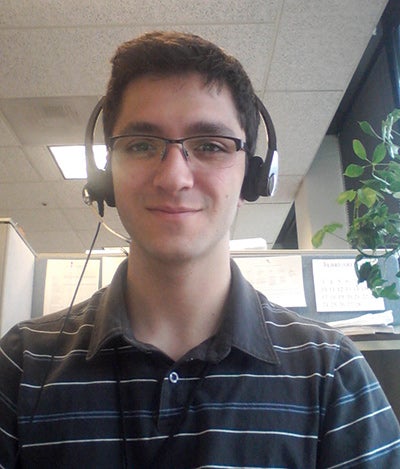bachelor of science '12
Brownfields cleanup offers fulfilling public service career
As a double major at the University of Oregon, Robert Tan’s course load featured a variety of classes, including one about, well, dirt.
“Though I can’t speak for everyone, I personally did not find ‘Soil 401’ to be the most exciting course offered at the U of O,” says Tan, who now works for the Environmental Protection Agency. “A friend of mine used to joke about the class being ‘boring as dirt’ with very little real-life application for the majority of people. [But] four years later, it turns out to be one of the most useful courses I’ve taken.”

Above: Robert Tan showing his true colors.
Tan is now Brownfields Project Manager with the Office of Environmental Cleanup in the EPA’s regional office in Seattle. He had a job nailed down with the EPA even before he graduated, thanks to a year-long internship program called Pathways, which is intended to promote civil service careers through paid training and development. A key advantage to completing the program is that the internship often converts into a permanent position with the federal government—as it did for Tan.
“As corny as it sounds, it is kind of my dream job,” says Tan, who double-majored in planning, public policy and management and environmental studies. “Working in the public sector, for an agency like EPA, there is an esprit de corps among the employees that I really love.[And] there is a good amount of flexibility to move about within the agency, which I think is more appealing to me at this point than considering external options” such as graduate school or working in private industry or a different federal agency than EPA.
Tan clearly enjoys his work and is committed to public service. “I’m currently working with a Native Village in Alaska to assess and clean up a former dumpsite that is impacting their community and water supply. The village is so rural and sparsely populated that leveraging the resources to finance a $100,000-plus cleanup is a significant challenge. It’s fairly early in the multiyear process, but I’ll be very happy if I can continue to assist and help move this project from cradle to grave.”
Choosing a combination of PPPM and environmental studies classes provided a thorough background in environmental policy for his job, he notes. “Some of the courses, such as Environmental Policy and Environmental Law, covered the specific laws and statutes that govern my current position at EPA. These courses really allowed me to hit the ground running when I first started.”

Above: Tan in his office at the EPA in Seattle.
It also didn’t hurt that while in school he was active in the Environmental Leadership Program through the Environmental Studies Program. “My group conducted energy audits and taught about climate change at local elementary and middle schools.”
Tan’s future plans remain loyal to the EPA. “It’s difficult to say where I’ll be in thirty years, but for now I’d love to maintain a career here. Eventually I think it would be great to get some experience working at one of our other regional offices or at headquarters in Washington, D.C. I might consider making a move or looking to complete a [temporary position] there in the future.”
His advice to current students? “Don’t wait until you graduate to start job hunting. The earlier on you can begin networking and developing contacts with the types of employers you would like to work for, the better you can customize your resume to match their needs,” he says. “Not every contact you make or every informational interview you conduct will result in job offers—the majority won’t—but you’d be surprised what doors will open from some of those connections.
